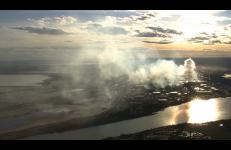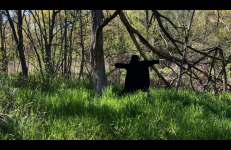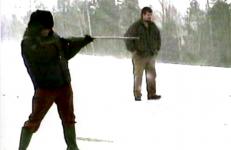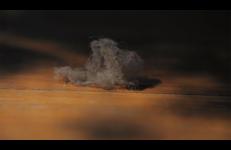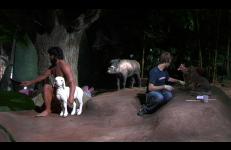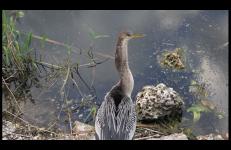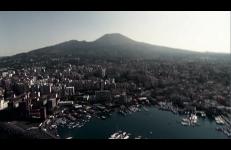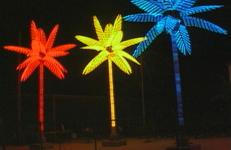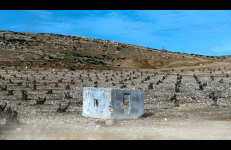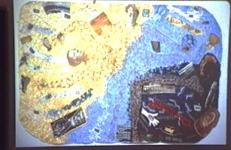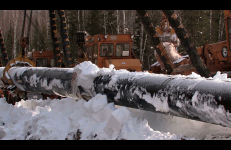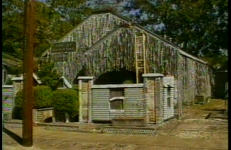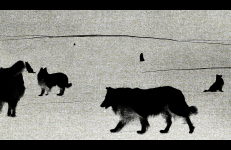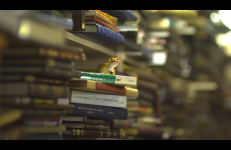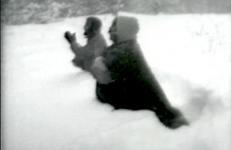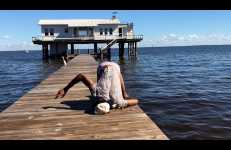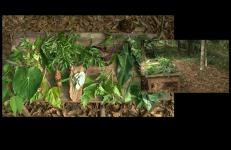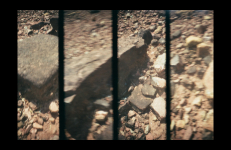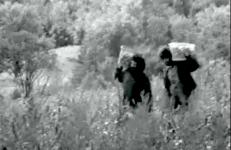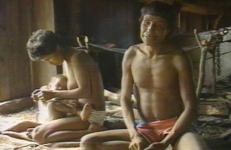Water and oil form the undercurrents of all narrations as they activate profound changes in the planetary ecology. After the oil peak, ever dirtier, remote and deeper layers of fossil resources are being accessed. Aerial recording of the devastated crust in Alberta opens the view into dark lubricant geologies. Climate change, exasperated by projects such as the Canadian tar sands, puts the life of large world populations in danger.
Environment
Eiko Otake, with her collaborator Merian Soto, visited a friend Bonnie Brooks in her country house and had a long walk in the forest. There was a small island occupied by three deers. They later returned to it and the deer were gone so Eiko danced in that place she named Deer Island.
“What's junk to some people, is treasure to others,” an idea that motivated the work of humanitarian Dorothy Davis. Dorothy Davis: Make a Way is as much a joyous celebration of spirit as an intimate portrait of Dorothy. This video documents her glorious creations and philosophies on recycling and duty to others. With her husband, Oliver, a scrap merchant, they struggle to provide care for pregnant girls and needy neighbors victimized by an unresponsive welfare system, in spite of their own poverty.
"This movie was collected for four years before being sprayed scattershot over 28 minutes of psychic mayhem. The line between living and dead is a frontier crossed and re-crossed here. The living are dead while the dead are animated, breathing, swimming, giving birth. Consumed by the animal life of the city, the artist undertakes a first person journey, producing diary notes from one of the most skilled lens masters of the new generation. The camera is her company in this duet of death, the instrument that permits her to see the impossible, the unbearable, the invisible."
A domestic portrait rendered at miniature scale, Dust Studies brushes along the edge of what can be seen. Staying close to the ground to collect what gathers there, the film looks deeply for everyday things and finds them drifting in the pleasant, meandering headwaters of a young child's language.
Note: This title is intended by the artist to be viewed in High Definition. While DVD format is available to enable accessibility, VDB recommends presentation on Blu-ray or HD digital file.
The Earth Is Young takes as its starting point a series of interviews conducted with Young Earth Creationists, who find evidence of a six-day, six-thousand-year old creation in their reading of the fossil and geological record. The film frames these encounters with depictions of the slow and patient work of young paleontologists, and the strange, shimmering life in a drop of pond water, both of which point toward a world far older and more complex, if no less fantastic.
A short documentary about life in the Everglades National Park with its few male residents. Living in the midst of a national park, they learn to exist with the wild. As a female moving image artist, Dana Levy takes on the role of an anthropologist, observing the men and how they interact with their surroundings. Apart from Levy, the only women that appear in Eden Without Eve are in erotic photographs taken by a resident named Lucky, who believes that women like having themselves put in romantic, exotic, and dangerous settings to be photographed.
"Living on the slopes of the volcano Vesuvius is a strange contradiction: always in stress and yet also sleepy, waiting for what might happen. In close cooperation with the Osservatorio Vesuviano and several inhabitants of the 'Red Zone' of the volcano, Rosa Barba constructs a lyrical portrait of this area, which shelters Mafia members and illegal Chinese immigrants. Historic footage, measurements, maps, and aerial shots try to capture what is always uncertain."
The frenzied detritus of trading floors, smart weaponry and the religious right are woven through the petrochemical landscapes of Southeast Texas. This short video harangue questions land use policy as it serves the oil industry, patriotism as it absolves foreign aggression, and fundamentalism as it calcifies thinking.
The project presents the blurring of the Green Line for Israelis and its consolidation for Palestinians, through important planning and legal decisions.
A billboard looming over the 5 Freeway advertised a mortuary called “Eternal Valley.” In Green Valley, California, the road stops, eroded and dysfunctional, but continues to be nothing other than a road.
Camera: Ramzi Hibri, Matthew Lax
Edit: Matthew Lax
Everglades is a project Levy began while a resident artist in Florida's Everglades National Park. The unique natural environment of the Everglades has been devastated by decades of wetlands drainage for purposes of industrial and residential development, and today it is threatened by fracking and deep water drilling. At the same time, efforts have been made to restore some of the original ecosystems through a process of re-flooding, not unlike the restoration of Lake Hula in the north of Israel.
Extractions parallels resource extraction with the booming child apprehension industry. As the filmmaker reviews how these industries have affected her, she reflects on having her own eggs retrieved and frozen to make an Indigenous baby.
A house covered with beer cans, a tribute to the orange; Eyeopeners features seven Houston, Texas, folk art environments, eye-opening creations that are monuments to the wonders of ingenuity and imagination. Expressions of profound instincts and powerful urges, the Eyeopeners sites remind us of the unselfconscious heights of expression that self-taught artists can attain. The video features the artists on-camera talking about these personal journeys and the forces that motivate their wo
A silent film essay considers the production of Robert Flaherty's seminal 1922 documentary, Nanook of the North (also known as, A Story Of Life and Love In the Actual Arctic). An image by an Inuk artist is discovered “missing” from the Museum of Modern Art (MOMA) collection.
Based on live testimony, historical documents from my Egyptian Jewish family’s archives, and fragments from the renowned Cairo Geniza discovered in the 19th century in the Ben Ezra synagogue in Cairo, which includes documents from the 9th-19th centuries. Fatherland Archives illuminates the vanished world of Egyptian Jewish life and culture.
Fifeville is a film about a neighborhood in Charlottesville, Virginia. It focuses on the details, gestures, and material life of the citizens of Fifeville as they communicate their understandings of the neighborhood’s changing landscape. Although Fifeville is set in Charlottesville, it could be Any Black Community Experiencing Gentrification, USA, 21st Century.
Co-director: Corey D.B. Walker. Crew: bh103a.
This video captures the playfulness of the Videofreex as they frolic in the first snow of 1971. With joyful excitement, David, Bart, Chuck, Nancy and Skip pass the camera back and forth to explore the possibilities for video under the new weather condition offered by flurries. While Nancy tapes, David and Bart create fictional characters stranded after a plane crash. Annie, Francis and the resident dog, Mushroom, join the group for further snowy shenanigans. Later, Bart tries to interview the local snowplow driver for an episode of Lanesville TV, but without success.
Developed in collaboration with and performed by DonChristian Jones.
The footage was filmed by Eiko during the Rauschenberg Foundation Residency in Captiva, FL in November 2017. Eiko edited the footage in Japan during her 2020 Virtual Creative Residency hosted by Wesleyan University. After editing, Eiko realized this is the first media work she created without her body.
Directed by Eiko Otake as a part of The Duet Project: Distance is Malleable.
The foliage and sprouting of urban greenery becomes the subject of this celebration to all things pollinated. The video explores hidden gardens that lie sequestered amid an array of dwellings inhabited by the not so rich and famous. Felines creep amid the blossoms as human entities enrich the soil with their leaking desires.
Forest Law underlines the persistent fact that we are yet to learn to live otherwise in an age defined by the colossal consequences of a new socio-geological order we ourselves have created through irresponsible interactions with Earth’s systems.
Forest Mind is a video work that emerges from the artist’s longstanding interest in the human interaction with the natural world. In a series of recent art projects, she has shed light on the cosmology of Indigenous communities and their political struggle to keep their forests alive.
Planetary battle over the porous body of the earth. This is the battle of the Earth.
A two-part study of the self-sustaining lifestyle of a communal farm in Vermont.
Over 6,000 gold prospectors invade the reserve of the Nambiquara of Sararé, and loggers raid the mahogany-rich forests, which are threatened by extinction. Pressure on the World Bank (with whom the government of Mato Grosso is negotiating a loan) could end prospecting, but the pillage of the forest continues.
In Portuguese with English subtitles.
Directed by Vincent Carelli, Maurizio Longobardi, and Virginia Valadão; edited by Tutu Nunes.




